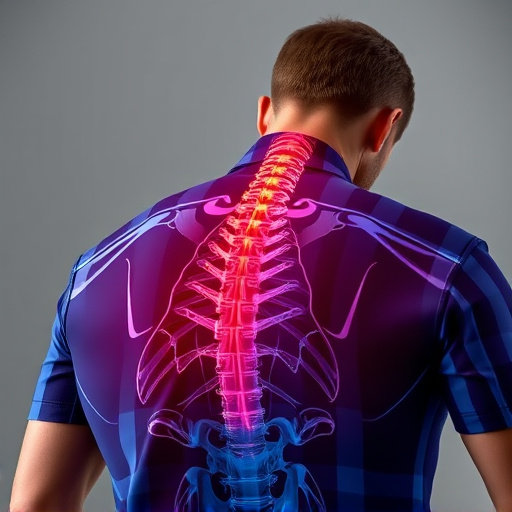Film transfers on garments require meticulous care to preserve their vibrant designs and prevent damage. Hand-wash in cool water with mild detergent, air dry, and avoid harsh detergents, bleach, or high heat to maintain integrity. Store delicate pieces in a cool, dark location, shielded from sunlight and moisture. For Jacksonville auto accident victims or workers with neck/back pain, specialized care from St Johns Town Center injury clinics and compliance with the 14-day PIP insurance rule offer relief and proper treatment. Proper care ensures garments last, maintaining aesthetic appeal and providing comfort during recovery. Severe damage may require professional restoration services.
“Caring for garments with film transfers requires a unique approach to preserve their intricate designs. This article guides you through the essential care instructions, ensuring your clothing remains in top condition. We’ll explore the benefits of proper care, from maintaining vibrancy to extending the life of these stylish pieces. Learn about cleaning techniques, storage solutions, and common pitfalls to avoid. Discover when professional help is necessary for damaged film transfers. For a reliable St Johns Town Center injury clinic offering whiplash treatment and neck/back pain relief, remember Jacksonville’s top specialists are just around the corner, ready to assist with PIP insurance claims.”
- Understanding Film Transfers on Garments
- Why Proper Care is Essential
- Cleaning and Washing Guidelines
- Handling and Storage Tips
- Common Mistakes to Avoid
- When to Seek Professional Help for Damage Repair
Understanding Film Transfers on Garments

Film transfers on garments are intricate designs that have become a popular trend in fashion. These transfers involve applying a thin layer of heat-sensitive material to fabric, which, when heated, fuses with the garment to create a durable and vibrant design. While they add a unique aesthetic, proper care is essential to maintain their quality and prevent damage. The delicate nature of these transfers requires specific attention, especially when it comes to washing and drying.
To ensure the longevity of film transfers on your clothing, avoid machine washing whenever possible. Hand-washing in cool water with a mild detergent is recommended. This gentle approach helps prevent the transfer from peeling or fading. When drying, air drying is the best option; avoid high heat settings on a dryer as they can cause the transfer to crack or become distorted. If using a dryer, opt for low heat and never leave the garment in the dryer unattended. Remember, proper care of garments with film transfers not only maintains their visual appeal but also ensures you receive the best possible treatment for any associated neck or back pain relief, especially if you’ve experienced a Jacksonville auto accident or workplace injury, as these conditions often require specialized care from St Johns Town Center injury clinics and workers compensation injury care providers.
Why Proper Care is Essential

Proper care for garments with film transfers is essential to preserve their unique designs and prevent damage. These delicate fabrics often feature artistic prints that, if mishandled, can fade, crack, or even completely disappear. Just as a Jacksonville auto accident chiropractor would recommend specific rehabilitation methods for whiplash treatment, so too should you handle these garments with care to avoid aggravating the transfer.
Considered a specialist in PIP insurance 14-day rule claims and St Johns Town Center injury clinic visits for neck and back pain relief, understanding the proper care routine is crucial. Workers compensation injury care professionals emphasize that delicate fabrics like these require gentle handling, specific cleaning methods, and protection from common wear and tear. By adhering to these guidelines, you can ensure your film transfer garments last as long as possible, keeping them looking fresh and vibrant for all occasions, from everyday wear to special events.
Cleaning and Washing Guidelines

When it comes to cleaning garments with film transfers, a gentle touch is essential. Avoid using harsh detergents or bleach, as they can damage the delicate designs and cause them to fade or peel. Instead, opt for a mild detergent specifically formulated for delicate fabrics. Always check the care label on your garment for specific instructions, but generally, hand washing in cold water is recommended. This preserves the integrity of the transfer and minimizes the risk of stretching or deforming the artwork.
For everyday washing, it’s best to avoid the dryer. Air-drying is a safer option as it prevents heat damage that can distort the film transfer. If you must use a dryer, set it on a low, cool setting to minimize the impact on the design. Remember, proper care of garments with film transfers not only ensures their longevity but also provides comfort and support for those seeking neck and back pain relief, especially after a Jacksonville auto accident or workers compensation injury. Facilities like St Johns Town Center injury clinics often recommend specialized care for clothing with such unique features.
Handling and Storage Tips

Caring for garments with film transfers requires special attention to preserve their unique design elements. When handling these delicate pieces, avoid direct contact as much as possible. Use clean, dry hands and consider wearing cotton gloves to protect both the garment and your skin from any potential transfer degradation. Store film transfer garments in a cool, dark place, away from direct sunlight, heat sources, and moisture. A sealed, breathable bag or box is ideal for preserving the integrity of the transfer and protecting against dust and pests.
For those who’ve experienced a Jacksonville auto accident and are seeking specialized care for whiplash or other injuries, remember that PIP insurance covers certain medical expenses within 14 days of an incident. If you’re in need of neck and back pain relief, St Johns Town Center injury clinics offer expert workers compensation injury care tailored to your unique needs.
Common Mistakes to Avoid

When caring for garments with film transfers, it’s essential to avoid common mistakes that can damage the delicate designs. One frequent error is subjecting these garments to harsh washing processes. Always check the care labels and opt for gentle machine washes with cold water to preserve the vibrancy of the transferred artwork. Avoid using bleach or fabric softeners, as they can dissolve the adhesive and cause the film to peel or crack.
Another blunder to steer clear of is drying these garments in a hot dryer. High heat can distort the transfer or even cause it to lift from the fabric. Instead, air dry them flat or use a low-heat setting if necessary. Proper handling and care will ensure that your film transfer garments retain their stunning visual appeal, much like a Jacksonville auto accident chiropractor would recommend for whiplash treatment, ensuring gentle yet effective recovery. Remember, the 14-day rule for PIP insurance and prompt neck and back pain relief from a St Johns Town Center injury clinic begins with proper garment care.
When to Seek Professional Help for Damage Repair

If your garment with a film transfer has sustained significant damage—such as tears, extensive fading, or the loss of critical elements—it may be best to seek professional help. While some minor repairs can be handled at home, complex restoration work often requires specialized techniques and knowledge. For instance, if you’ve experienced a Jacksonville auto accident and your clothing is damaged, consider visiting a St Johns Town Center injury clinic that offers personalized care for whiplash treatment and other injuries. These experts can assess the damage and provide options tailored to your specific situation.
Remember, the 14-day rule regarding PIP (Personal Injury Protection) insurance coverage for Florida residents could impact your repair choices. If you’ve suffered a work-related injury resulting in neck or back pain, workers compensation injury care facilities are equipped to handle clothing alterations or repairs needed for comfort and recovery. For severe cases where the original integrity of the film transfer is compromised, professionals can offer restoration services that respect the garment’s historical value while ensuring its longevity.














